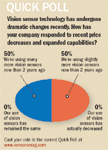SOFTWARE
SOA Adoption at 90%
In his monthly Extreme Data column (which takes a break this issue), Tom Kevan has described how service oriented architecture (SOA) software enhances the value of sensor data by making them easily available to large numbers of users.
Now comes a benchmark report from the Aberdeen Group saying 9 of every 10 companies are adopting or have adopted SOAs and will finish 2006 with SOA planning, design, and programming experience. The report is available publicly thanks to underwriting from IBM, Fiorano, and TIBCO Software. (www.sensorsmag.com/1106/SCsoa1)
Among SOA product options is a new entry from Oracle. The company claims the industry's first integrated, standards-based product to help organizations build, deploy, and manage event-driven applications. Oracle Event-Driven Architecture Suite includes middleware that allow you to sense, identify, analyze, and respond to business events in real time. Among these is Oracle Sensor Edge Server, which captures, filters, and manages events from physical sensors and automation equipment, including RFID. Event-driven architecture (EDA) is a key component of next-generation SOA 2.0, which defines how events and services link together to deliver a flexible and responsive IT infrastructure. (www.sensorsmag.com/1106/SCsoa2)
PROCESS IINDUSTRIES
Picturing Petroleum
In its quest to exploit ever-more difficult-to-access reserves, the petroleum industry is finding high-end sensors increasingly appealing. Traditionally costly high-quality seabed seismic data acquisition "is emerging as a valuable solution," says Input/Output Inc., maker of the VectorSeis ocean bottom cable (OBC) seismic imaging system. Equipped with digital sensors for multicomponent data acquisition on the seabed, VectorSeis is designed to enable productivity improvements and high-resolution, full-wave imaging. (www.sensorsmag.com/1106/SCss1)
 |
Along similar lines, Weatherford International Ltd. says it has made the world's first successful offshore installation of a permanent in-well optical seismic system—for British Petroleum. The system provides continuous seismic and pressure/temperature monitoring and interfaces to the existing permanent OBC system, enabling simultaneous collection of both seabed and downhole data. This, says Weatherford, represents a milestone: It allows for new applications and also represents a means for calibrating remote production with in-well observations. (www.sensorsmag.com/1106/SCss2)
MEDIA WATCH
Revolution Running
"The sensor revolution is off and running," says a recent BusinessWeek Online article, "Tech Wave 2: The Sensor Revolution," noting that, "While the last 50 years have been dominated by a march to ever more complex computers, the next few decades will see the rise of simple sensors—by the billions." The article describes wireless sensor networking and RFID technologies and some key applications. (www.sensorsmag.com/1106/SCbw)
Sensors Tag Assets
In the article, "IBM Software Tracks Computers, Trucks," c|netnews.com describes how IBM is planning to offer "unified management tools" capable of tracking IT gear and physical assets—such as trucks and shipping containers—with electronic sensors.
 Quick Poll |
"Non-IT assets are getting embedded chips, embedded software stacks and IP (Internet protocol) addresses," said Al Zollar, general manager of IBM's Tivoli division. "They have to be managed just like servers and desktops." (www.sensorsmag.com/1106/SCcnet)